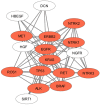Prognostic Factors and Markers in Non-Small Cell Lung Cancer: Recent Progress and Future Challenges
- PMID: 37895255
- PMCID: PMC10606762
- DOI: 10.3390/genes14101906
Prognostic Factors and Markers in Non-Small Cell Lung Cancer: Recent Progress and Future Challenges
Abstract
Lung cancer is a highly aggressive neoplasm and, despite the development of recent therapies, tumor progression and recurrence following the initial response remains unsolved. Several questions remain unanswered about non-small cell lung cancer (NSCLC): (1) Which patients will actually benefit from therapy? (2) What are the predictive factors of response to MAbs and TKIs? (3) What are the best combination strategies with conventional treatments or new antineoplastic drugs? To answer these questions, an integrative literature review was carried out, searching articles in PUBMED, NCBI-PMC, Google Academic, and others. Here, we will examine the molecular genetics of lung cancer, emphasizing NSCLC, and delineate the primary categories of inhibitors based on their molecular targets, alongside the main treatment alternatives depending on the type of acquired resistance. We highlighted new therapies based on epigenetic information and a single-cell approach as a potential source of new biomarkers. The current and future of NSCLC management hinges upon genotyping correct prognostic markers, as well as on the evolution of precision medicine, which guarantees a tailored drug combination with precise targeting.
Keywords: EGFR mutations; NSCLC; genotyping; lung cancer; prognostic markers.
Conflict of interest statement
The authors declare no conflict of interest.
Figures



References
Publication types
MeSH terms
Substances
LinkOut - more resources
Full Text Sources
Medical
Research Materials
Miscellaneous

